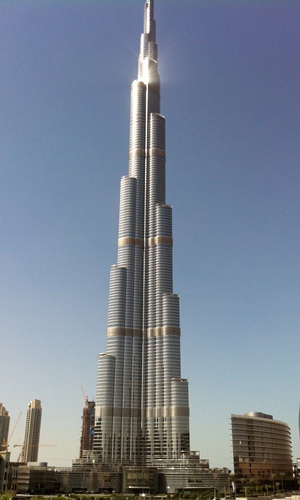Burj Khalifa - Dubai
For thousands of years, the Great Pyramid of Giza was the tallest manmade object in the world â until 1300, when the title was swept away by the Lincoln Cathedral, and subsequently by other edifices across the globe. Now, centuries later, the home of the worldâs tallest structure has, at last, been wrested back to the Arab world. Dubaiâs Burj Khalifa is an iconic building, representing the innovation and architectural vision that the emirate is famous for. The Burj takes its place amongst the other wonders that have blossomed in this desert: islands shaped like palm trees, enormous indoor ski slopes, an archipelago of hundreds of islets that form a map of the world â and surpasses them all. The 829-metre tall structure glistens throughout the bright day, its glass and steel exterior elegantly reflecting the sunlight, visible throughout the city like a shining, majestic torch. Nothing else that has been built by man comes close to its height: Taiwanâs Taipei 101, the nearest match, is only 508 metres high. Burj Khalifa is also a symbol of international cooperation: designed by architect Adrian Smith of Chicago-based firm Skidmore, Owings and Merrill, it took over 22 million man hours to complete this emblematic skyscraper.
Burj Khalifa was built in an astonishing six years, with challenge after challenge overcome to ensure its successful completion. Engineers understood that in order to support the buildingâs exceptional height, a new structural system had to be developed: they designed a hexagonal core reinforced by a y-shaped, modular structure. The result is an exceptionally stable footprint with an elegant twist: its design inspiration comes from patterns in Islamic architecture, and from a desert flower widely cultivated in the region, the hymenocallis. From the top of the building, viewers can see for almost 100 kilometres, and the triple-lobed design also maximizes views of the shimmering Arabian Gulf, one of Dubaiâs most pleasurable draws.
Other construction challenges abounded, only to be overcome by the ingenuity and resourcefulness of Burj Khalifaâs builders. The exterior cladding was designed with Dubaiâs extreme summer temperatures in mind; it can not only withstand the shattering heat, but takes into account the differences in temperature (around 6°C) between the top of the building and its base. It was also necessary to negotiate the challenges posed by the wind, and the buildingâs potential responses to it â particularly at the Burjâs lofty peak. Architects, engineers and consultants conducted rigorous tests in order to determine key elements of the structureâs design. The 160-storey skyscraper is able to hold up to 35,000 people at any given moment, all of whom would require elevator transport. Current technology is unable to construct an elevator that can zoom up the buildingâs entire height, and so a transfer system was designed to connect elevators serving different sections of the building.
The Burj is not only the tallest structure in the world: it has broken (or set) a number of other records. These include the worldâs highest outdoor observation deck, swimming pool, and mosque, as well as the tallest service elevator and the very first Armani hotel. An apposite emblem of Dubaiâs transformation from a sleepy fishing village to a global hub, Burj Khalifa stands tall as a testament to the power of the human imagination.
Written by Rawan Hashem Alkhatib
  Â
